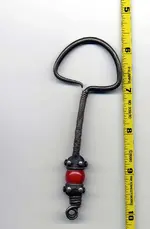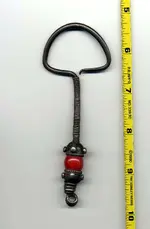I was raised in Price Utah and I have had an item in my possession for 50 years that I would like to identify. I think it might be Spanish, but I don't have much information on the item other than what I remember. I recall my father bringing it home and said someone found it in the desert. Where I don't know, but somewhere around the Price area. The Spanish Trail is just south of Price.
It is not ferrous metal (magnet test). I think it is a low grade silver. It appears to be hand made and ornamental. I think this was a piece of something that broke off. The red ball is a glass bead with a dark blue enameled cap on either side. I can send more pictures (better detail) is anyone is interested
I have attached a couple of pictures. If you know of anyone who could help identify this I would appreciate a email address.
It is not ferrous metal (magnet test). I think it is a low grade silver. It appears to be hand made and ornamental. I think this was a piece of something that broke off. The red ball is a glass bead with a dark blue enameled cap on either side. I can send more pictures (better detail) is anyone is interested
I have attached a couple of pictures. If you know of anyone who could help identify this I would appreciate a email address.





 It's interesting and I hope it gets identified.
It's interesting and I hope it gets identified.
 or was I seeing things lol
or was I seeing things lol ). (Hey, you're not a narc are you? Ha! Ha! ....memories!) Anyway, that fact would lead to the assumption that more obvious clips existed before '63, and your's might be one. If it is, it would no doubt be very collectable.
). (Hey, you're not a narc are you? Ha! Ha! ....memories!) Anyway, that fact would lead to the assumption that more obvious clips existed before '63, and your's might be one. If it is, it would no doubt be very collectable.